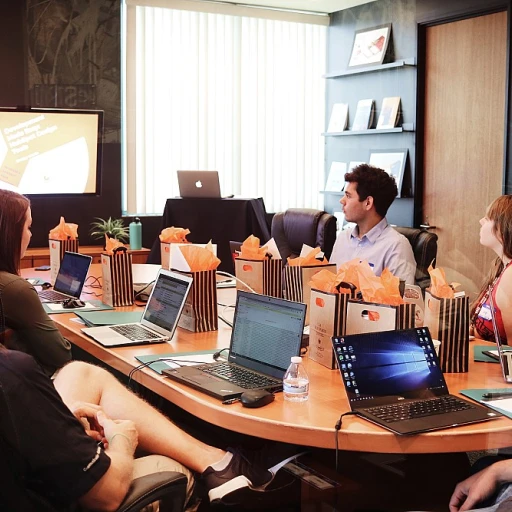
Understanding Employee Engagement
Recognizing the Core of Employee Engagement
In the ever-evolving landscape of workforce planning, understanding employee engagement is crucial for any successful organization. The focus on hiring and nurturing talent can't be overstated. But what exactly does employee engagement entail? At its core, employee engagement revolves around the emotional and mental connection that employees have with their work and company. It's a vital component of job performance and overall job satisfaction. Creating a thriving environment requires more than just filling positions with high potential candidates. It demands a strategy that involves understanding the unique needs of each employee and aligning them with the business goals. This means that recruitment and hiring decisions should prioritize individuals whose skills and potential align with the organization's long-term objectives. Effective employee engagement leads to a myriad of benefits:- Improved Performance: Engaged employees tend to perform better, meeting and often exceeding company expectations.
- Reduced Turnover: When employees feel connected and valued, they are less likely to leave, aiding in succession planning.
- High Productivity: Engaged employees contribute positively to the company at a higher level, enhancing overall productivity.
Identifying Signs of Underutilized Talent
Recognizing the Signs of Untapped Potential
In the ever-evolving landscape of business, ensuring employees are appropriately challenged is crucial for optimizing organizational performance. Recognizing when top talent is not being utilized to its fullest potential is a critical step in workforce planning and management. Through careful analysis of job descriptions, employee performance metrics, and job roles, management teams can identify discrepancies between employee skills and their daily tasks. Employers need to be vigilant about specific indicators that suggest their workforce may not be as engaged as desired. The following are some signs that talent might be underutilized and in need of more engaging tasks:- Declining Job Performance: A noticeable dip in performance can indicate that the task doesn't match the employee’s skills or potential. Employees who excel when given challenging projects but perform poorly in monotonous tasks could be a sign that their abilities are not being fully harnessed.
- Lack of Enthusiasm: Employees who are typically passionate about their work might show less energy if their tasks are too repetitive. This often translates to a lack of interest in team activities and a withdrawal from workforce collaboration.
- Feedback Patterns: Regular feedback sessions often reveal an employee's dissatisfaction with their current role. Feedback is a two-way street; while it is necessary to provide insights on performance, it also reflects what employees think about their job assignments.
- High Turnover or Absenteeism: An increase in turnover rates or absenteeism within the team could reflect a broader issue where employees feel unchallenged and are seeking opportunities elsewhere. This can be an early warning sign that recruitment strategies need to focus more on aligning employee potential with job demands.
The Impact of Monotonous Tasks on Employee Morale
The Consequence of Mundane Assignments on Team Spirit
It's crucial for organizations to understand that monotonous tasks can have significant repercussions on employee morale. The repetition of dull assignments without opportunities for growth or creativity often leads to disengagement. An employee’s level of job satisfaction directly influences their job performance, which is why it’s important to address when tasks do not align with their skills or potential.
Monotonous tasks generally fail to utilize the diverse skills that employees bring to the table. This is not just a missed opportunity for the employee to grow, but for the company to capitalize on inherent potential. When job descriptions and responsibilities do not match an employee's capabilities or aspirations, it results in high potential talent feeling stagnant, ultimately impacting their overall outlook on work.
Inconsistent talent management practices or poor workforce planning could also exacerbate this issue. Over time, even the most dedicated employees might start to question their role within the organization, which might lead them to seek opportunities elsewhere where their skills and ambitions are better recognized. For hiring managers and recruitment specialists, understanding and mitigating these risks should be integral to the company’s hiring strategy and succession planning.
To tackle the problems caused by uninspiring tasks, organizations should lean on data-driven analysis to regularly track employee sentiments and needs. By doing so, companies can adjust job roles and responsibilities to better match the specific skills and long-term aspirations of their workforce. This proactive approach not only enhances the employee experience but also aligns daily tasks with business goals, paving the way for future high performance.
Strategies for Assigning Meaningful Tasks
Unleashing Potential Through Strategic Task Assignment
Creating a strategy to assign meaningful tasks can significantly enhance job performance and workforce planning. It's crucial to understand the talents and specific skills of each employee, allowing you to match them with tasks that align with their potential.- Analyze Employee Skills and Interests: Using data-driven analysis, managers can identify the skills and interests of their employees. This information helps in aligning tasks that not only meet company business goals but also keep employees engaged.
- Incorporate Developmental Goals: Integrating skill-based tasks that cater to an employee's long-term development needs can maximize both performance and job satisfaction. For instance, identifying high-potential employees and assigning them to challenging roles can foster their professional growth.
- Maintain Flexibility in Task Assignment: A flexible approach allows for dynamic allocation of responsibilities, ensuring that employees do not become constrained by rigid job descriptions. This adaptability is crucial, especially given the changing needs of the company and employees alike.
- Collaborate Between Hiring Managers and Employees: Open dialogue between hiring managers and talent helps in establishing clear expectations and provides opportunities for employees to express their aspirations. This practice contributes to succession planning and enhances the overall employee experience.
The Role of Feedback in Task Assignment
The Significance of Constructive Feedback
Feedback, both positive and constructive, acts as a pivotal tool for understanding and enhancing employee experience. As hiring managers and management professionals, relying on intuition is not enough when it comes to task assignment. A structured feedback mechanism helps bridge the gap between employee needs and company goals. When feedback is regular and transparent, it enables the identification of specific employee skills that may be underutilized. High potential employees can harness this feedback to channel their energy into meaningful work that aligns with their talents and the company's business objectives. This nurtures a culture of open communication and continuous development, much needed in today's fast-paced work environment. Utilizing data-driven analysis during feedback sessions can highlight areas where talent is either excelling or in need of further development. This, in turn, aids in refining recruitment strategies and workforce planning to ensure that job positions and descriptions are tailored to accommodate individual strengths. Implementing feedback best practices includes:- Conducting regular performance reviews to assess job performance
- Setting clear expectations and providing actionable insights for potential employees
- Encouraging a two-way communication channel for employees to express their thoughts on job satisfaction and task engagement
Creating a Culture of Continuous Development
Nurturing a Proactive Learning Environment
Creating a culture where continuous development is prioritized plays a pivotal role in maintaining a dynamic workforce. This proactive approach does not only improve employee performance but also aligns with the long-term business goals of the company. Companies that invest in skills-based strategies often see improvements in both job performance and employee satisfaction.
A workforce that is constantly being challenged with new tasks and learning opportunities tends to be more engaged. It is essential for management to recognize the potential employees hold and provide avenues for them to hone their specific skills. This tactic aids in identifying and developing high potential candidates, who can eventually take on larger roles within the company.
For a more effective workforce planning, regular analysis of employee skills and performance data can provide insights into areas where additional training might be needed. This data-driven approach facilitates informed hiring decisions and validates the company's hiring strategy.
To foster development, companies should encourage feedback loops among employees, allowing them to communicate their needs and suggest potential areas for growth. Encouraging an open dialogue will help track employee progress and align their personal development goals with broader company objectives.
Best practices also include setting up mentorship programs that pair experienced employees with newer ones, ensuring the transfer of knowledge and the building of a supportive environment. Succession planning could also involve identifying top talent and preparing them for future leadership roles, which reinforces the company’s commitment to ongoing growth and employee experience.













